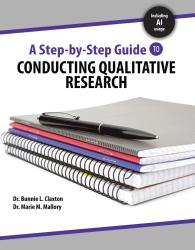A Step-by-Step Guide to Conducting Qualitative Research
Author(s): Bunnie Loree Claxton , Marie Mallory
Edition: 1
Copyright: 2024
Pages: 312
Edition: 1
Copyright: 2024
Pages: 312
Choose Your Format
Choose Your Platform | Help Me Choose
Print Package
$105.00 USD
A Step-By-Step Guide to Conducting Qualitative Research was written to guide the novice researcher through the qualitative dissertation research process. The qualitative researcher will study the day-to-day lived experiences of participants and will seek to discover and narratively describe the participants’ perspective in a final research manuscript using a phenomenology, case study, narrative, ethnography, or grounded theory research design. A chapter is included regarding the ethical use of generating content using artificial intelligence (AI), and how to defend the research.
Chapter 1: Introduction to Qualitative Research
Introduction to Qualitative Research
Qualitative Research Defined
Qualitative Research Designs
Phenomenological
Case Study
Narrative
Ethnography
Grounded Theory
Planning and Designing Qualitative Research
Theoretical Framework
Position Yourself in the Research
Philosophical Assumptions
Conclusion
Chapter Highlights
Chapter 2: How to Write the Front Matter
Introduction
Outline of a Qualitative Manuscript
How to Write the Front Matter
How to Write the Title Page
How to Write the Approval Page
How to Write the Abstract
How to Write the Table of Contents
Conclusion
Chapter Highlights
Chapter 3: How to Write Chapter One: Introduction
Introduction
How to Write the Overview
How to Write the Background
How to Write the Problem Statement
How to Write the Purpose Statement
How to Write the Significance of the Study
How to Write the Research Question(s)
How to Write the Definitions
How to Write the Summary
Conclusion
Chapter Highlights
Chapter 4: How to Write Chapter Two: Literature Review
Introduction
How to Analyze and Synthesize Scholarly Literature
Steps to Compose a Literature Review
How to Write a Literature Review Outline
How to Write a Literature Review
How to Write the Overview
How to Write the Theoretical Framework
How to Write the Related Literature
How to Write a Summary
Conclusion
Chapter Highlights
Chapter 5: How to Write Chapter Three: Methods
Introduction
How to Write the Overview
How to Write the Research Design
How to Write the Research Question(s)
How to Write the Role of the Researcher
How to Write the Trustworthiness
How to Write the Setting and Participants
How to Write the Ethical Considerations
How to Write the Procedures Section
How to Write the Summary
Chapter 6: Interviews and Focus Groups
Introduction
Differences Between Interviews and Focus Groups
Types of Interviews
How to Write Interview Questions
Tips for Writing Interview Questions
Steps to Conduct an Interview
How to Write the Interview Procedures
How to Analyze Interview Data
Conclusion
Chapter Highlights
Chapter 7: Questionnaires
Introduction
Qualitative Questionnaires
Types of Questionnaires
How to Write Questionnaire Questions
How to Create a Questionnaire
Steps to Conduct Questionnaire Research
How to Write Questionnaire Procedures
How to Analyze Questionnaire Data
Conclusion
Chapter Highlights
Chapter 8: Observations
Introduction
Observations
Types of Observations
Steps to Conduct an Observation
How to Analyze Observation Data
How to Analyze and Report Field Notes
How to Write the Observation Procedures
Conclusion
Chapter Highlights
Chapter 9: Content Analysis
Introduction
Archival Data
Types of Document Analysis
Qualitative Methods
Steps to Conduct a Qualitative Content Analysis
How to Write the Qualitative Content Analysis Procedure
Conclusion
Chapter Highlights
Chapter 10: How to Write Chapter Four: Findings
Introduction
How to Write the Overview
How to Write the Description of Participants
How to Write the Codes and Themes Development
How to Write the Findings
How to Write the Summary
Conclusion
Chapter Highlights
Chapter 11: How to Write Chapter Five: Discussion
Introduction
How to Write the Overview
How to Write the Discussion
How to Write the Implications
How to Write the Limitations
How to Write the Recommendations for Future Research
How to Write the Summary
Conclusion
Chapter Highlights
Chapter 12: How to Defend Your Research
Introduction
The Presentation
The Proposal Defense
The Final Defense
Conclusion
Chapter 13: How to Publish Your Research
Introduction
How to Transform Your Dissertation into a Manuscript for Publication
Steps to Publish Your Research
Conclusion
Chapter Highlights
Chapter 14: How to Generate Content Using AI
Introduction to Artificial Intelligence (AI) in Doctoral Research
AI Defined
The Purpose of AI in Doctoral Research
How to Generate Content Using AI
Steps to Generate Content Using AI
How to Use Content Generated by AI
Limitations of AI in Education
AI and Ethical Considerations
Conclusion
Chapter Highlights
References
Appendices
Dr. Bunnie L. Claxton is the founder and chief executive officer of Dissertation Research Specialist, a company that supports the implementation of doctoral programs in universities around the world. She currently serves as a consultant to universities regarding dissertation research to assist with program development, course development, and faculty training. She also provides support to doctoral candidates through her website www.dissertationspecialist.com. She is an adjunct instructor, subject matter expert, and dissertation chair for multiple universities. She is an international speaker, and she presented her research at Oxford University and Cambridge University in 2025. She was the keynote speaker for the World Conference on Teaching and Education in Berlin, Germany. Formerly, she served as the director of applied doctoral research at Liberty University. Dr. Claxton has been involved in the field of education since 1994, including public school, private school, home school, and higher education. Dr. Claxton served as the superintendent for Liberty University Online Academy, an online K–12 school with over 16,000 students, and she currently serves on the board of directors. She is the author of 20 textbooks and is best known for her Step-by-Step textbook series. A few titles include A Step-by-Step Guide to Conducting Applied Research, A Step-by-Step Guide to Conducting Qualitative Research, A Step-by-Step Guide to Conducting Quantitative Research, A Step-by-Step Guide to Writing a Literature Review for Doctoral Research, and A Step-by-Step Introduction to Research Methods: Qualitative, Quantitative, Mixed-Methods, and Applied.
Dr. Marie M. Mallory is the Residential Chair of the Strategic and Personal Communication Department and Co-Director of the Graduate Program at Liberty University, a Subject Matter Expert, an Instructional Mentor, and a Thesis and Dissertation Chair. She is also an adjunct professor for Liberty University Online’s Ph.D. program and at Messiah University and oversees the Advertising and Forensic teams at Liberty University. She has 21 years of experience in the field of education, including public, private, homeschool, and higher education. She has developed multiple undergraduate, graduate, and doctorate-level courses, undergraduate and graduate programs, and is a research methodologist. She is an active member of multiple communication and education associations.
A Step-By-Step Guide to Conducting Qualitative Research was written to guide the novice researcher through the qualitative dissertation research process. The qualitative researcher will study the day-to-day lived experiences of participants and will seek to discover and narratively describe the participants’ perspective in a final research manuscript using a phenomenology, case study, narrative, ethnography, or grounded theory research design. A chapter is included regarding the ethical use of generating content using artificial intelligence (AI), and how to defend the research.
Chapter 1: Introduction to Qualitative Research
Introduction to Qualitative Research
Qualitative Research Defined
Qualitative Research Designs
Phenomenological
Case Study
Narrative
Ethnography
Grounded Theory
Planning and Designing Qualitative Research
Theoretical Framework
Position Yourself in the Research
Philosophical Assumptions
Conclusion
Chapter Highlights
Chapter 2: How to Write the Front Matter
Introduction
Outline of a Qualitative Manuscript
How to Write the Front Matter
How to Write the Title Page
How to Write the Approval Page
How to Write the Abstract
How to Write the Table of Contents
Conclusion
Chapter Highlights
Chapter 3: How to Write Chapter One: Introduction
Introduction
How to Write the Overview
How to Write the Background
How to Write the Problem Statement
How to Write the Purpose Statement
How to Write the Significance of the Study
How to Write the Research Question(s)
How to Write the Definitions
How to Write the Summary
Conclusion
Chapter Highlights
Chapter 4: How to Write Chapter Two: Literature Review
Introduction
How to Analyze and Synthesize Scholarly Literature
Steps to Compose a Literature Review
How to Write a Literature Review Outline
How to Write a Literature Review
How to Write the Overview
How to Write the Theoretical Framework
How to Write the Related Literature
How to Write a Summary
Conclusion
Chapter Highlights
Chapter 5: How to Write Chapter Three: Methods
Introduction
How to Write the Overview
How to Write the Research Design
How to Write the Research Question(s)
How to Write the Role of the Researcher
How to Write the Trustworthiness
How to Write the Setting and Participants
How to Write the Ethical Considerations
How to Write the Procedures Section
How to Write the Summary
Chapter 6: Interviews and Focus Groups
Introduction
Differences Between Interviews and Focus Groups
Types of Interviews
How to Write Interview Questions
Tips for Writing Interview Questions
Steps to Conduct an Interview
How to Write the Interview Procedures
How to Analyze Interview Data
Conclusion
Chapter Highlights
Chapter 7: Questionnaires
Introduction
Qualitative Questionnaires
Types of Questionnaires
How to Write Questionnaire Questions
How to Create a Questionnaire
Steps to Conduct Questionnaire Research
How to Write Questionnaire Procedures
How to Analyze Questionnaire Data
Conclusion
Chapter Highlights
Chapter 8: Observations
Introduction
Observations
Types of Observations
Steps to Conduct an Observation
How to Analyze Observation Data
How to Analyze and Report Field Notes
How to Write the Observation Procedures
Conclusion
Chapter Highlights
Chapter 9: Content Analysis
Introduction
Archival Data
Types of Document Analysis
Qualitative Methods
Steps to Conduct a Qualitative Content Analysis
How to Write the Qualitative Content Analysis Procedure
Conclusion
Chapter Highlights
Chapter 10: How to Write Chapter Four: Findings
Introduction
How to Write the Overview
How to Write the Description of Participants
How to Write the Codes and Themes Development
How to Write the Findings
How to Write the Summary
Conclusion
Chapter Highlights
Chapter 11: How to Write Chapter Five: Discussion
Introduction
How to Write the Overview
How to Write the Discussion
How to Write the Implications
How to Write the Limitations
How to Write the Recommendations for Future Research
How to Write the Summary
Conclusion
Chapter Highlights
Chapter 12: How to Defend Your Research
Introduction
The Presentation
The Proposal Defense
The Final Defense
Conclusion
Chapter 13: How to Publish Your Research
Introduction
How to Transform Your Dissertation into a Manuscript for Publication
Steps to Publish Your Research
Conclusion
Chapter Highlights
Chapter 14: How to Generate Content Using AI
Introduction to Artificial Intelligence (AI) in Doctoral Research
AI Defined
The Purpose of AI in Doctoral Research
How to Generate Content Using AI
Steps to Generate Content Using AI
How to Use Content Generated by AI
Limitations of AI in Education
AI and Ethical Considerations
Conclusion
Chapter Highlights
References
Appendices
Dr. Bunnie L. Claxton is the founder and chief executive officer of Dissertation Research Specialist, a company that supports the implementation of doctoral programs in universities around the world. She currently serves as a consultant to universities regarding dissertation research to assist with program development, course development, and faculty training. She also provides support to doctoral candidates through her website www.dissertationspecialist.com. She is an adjunct instructor, subject matter expert, and dissertation chair for multiple universities. She is an international speaker, and she presented her research at Oxford University and Cambridge University in 2025. She was the keynote speaker for the World Conference on Teaching and Education in Berlin, Germany. Formerly, she served as the director of applied doctoral research at Liberty University. Dr. Claxton has been involved in the field of education since 1994, including public school, private school, home school, and higher education. Dr. Claxton served as the superintendent for Liberty University Online Academy, an online K–12 school with over 16,000 students, and she currently serves on the board of directors. She is the author of 20 textbooks and is best known for her Step-by-Step textbook series. A few titles include A Step-by-Step Guide to Conducting Applied Research, A Step-by-Step Guide to Conducting Qualitative Research, A Step-by-Step Guide to Conducting Quantitative Research, A Step-by-Step Guide to Writing a Literature Review for Doctoral Research, and A Step-by-Step Introduction to Research Methods: Qualitative, Quantitative, Mixed-Methods, and Applied.
Dr. Marie M. Mallory is the Residential Chair of the Strategic and Personal Communication Department and Co-Director of the Graduate Program at Liberty University, a Subject Matter Expert, an Instructional Mentor, and a Thesis and Dissertation Chair. She is also an adjunct professor for Liberty University Online’s Ph.D. program and at Messiah University and oversees the Advertising and Forensic teams at Liberty University. She has 21 years of experience in the field of education, including public, private, homeschool, and higher education. She has developed multiple undergraduate, graduate, and doctorate-level courses, undergraduate and graduate programs, and is a research methodologist. She is an active member of multiple communication and education associations.





